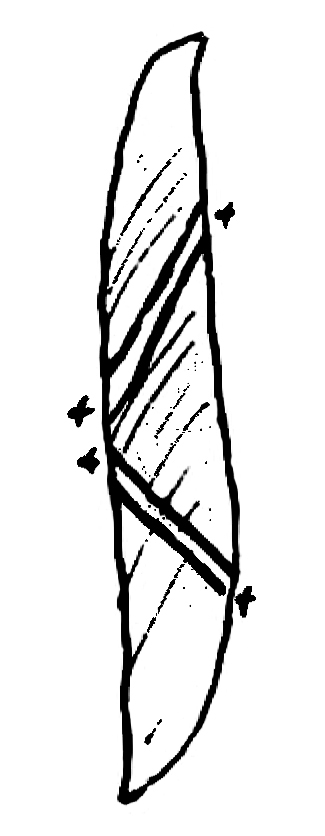From Daniel Oliver 27 November 1863
Royal Gardens Kew
27. Nov. 1863
My dear Sir
It was very kind of you to trouble to send the reference to Wyman’s paper.1 I understood it was in Boston Journal.2 I must look it up next time I go in to the Societies.3
The hygroscopic bundles in pods of Pentaclethra undergo wonderful amount of extension when moistened—increasing about 16 per Cent. It is curious that this extension is in direction of the length of the cells of the contracting & expanding tissue. In Common Pea, Lathyrus &c. the contraction on drying—causing curling up of valves is in direction of breadth of the cells. In wood the principal contraction is also transverse.4 It is curious to cut with scissors the strips marked from pod of sweet Pea dry, & put one of them in water a few minutes & ⟨then⟩ compare.

The directio⟨n of⟩ cells of contracting ⟨tissue⟩ is indicated on inner ⟨surface⟩ of the valves ⟨by the⟩ fine striation. The p⟨ods⟩ shd. be cut to equal le⟨ngth⟩5
I see v. Mohl is wr⟨iting⟩ in Bot. Zeit. on the s⟨mall⟩ hermetic flowers of Oxali⟨s⟩ ⟨ ⟩6
He has made more ⟨ ⟩ obs. than we previously ⟨ ⟩ but seems to attach u⟨ndue⟩ importance to the phen⟨omenon⟩7
If there were any p⟨ods⟩ with these flowers only ⟨ ⟩ might be ground for such.
However he makes out that Fumaria is necessarily a self-fertilizing plant & makes a little flourish about it which by the way I think you have made some observations wh. may enable you to refute him.8
I forget whether you said you had actually found bees carrying pollen of Fumitories.9 But it is too bad of me troubling you about things while so poorly.
Very sincerely yours | Danl. Oliver
I tho’t of noticing Mohl in N.H.R. & would refer to yr. obs. on Fumitory if worth while?10
CD annotations
Footnotes
Bibliography
Calendar: A calendar of the correspondence of Charles Darwin, 1821–1882. With supplement. 2d edition. Edited by Frederick Burkhardt et al. Cambridge: Cambridge University Press. 1994.
Collected papers: The collected papers of Charles Darwin. Edited by Paul H. Barrett. 2 vols. Chicago and London: University of Chicago Press. 1977.
Correspondence: The correspondence of Charles Darwin. Edited by Frederick Burkhardt et al. 29 vols to date. Cambridge: Cambridge University Press. 1985–.
Cross and self fertilisation: The effects of cross and self fertilisation in the vegetable kingdom. By Charles Darwin. London: John Murray. 1876.
Desmond, Ray. 1994. Dictionary of British and Irish botanists and horticulturists including plant collectors, flower painters and garden designers. New edition, revised with the assistance of Christine Ellwood. London: Taylor & Francis and the Natural History Museum. Bristol, Pa.: Taylor & Francis.
Mohl, Hugo von. 1863. Einige Beobachtungen über dimorphe Blüthen. Botanische Zeitung 21: 309–15, 321–8.
Orchids: On the various contrivances by which British and foreign orchids are fertilised by insects, and on the good effects of intercrossing. By Charles Darwin. London: John Murray. 1862.
Origin: On the origin of species by means of natural selection, or the preservation of favoured races in the struggle for life. By Charles Darwin. London: John Murray. 1859.
Wyman, Jeffries. 1854. [Cause of contractility in some vegetable tissues.] [Read 8 November 1854.] Proceedings of the American Academy of Arts and Sciences 3 (1852–7): 167–8.
Summary
Discusses the contraction of hygroscopic bundles in seed-pods,
and a paper by Hugo von Mohl ["Über dimorphe Blüthen", Bot. Ztg. (1863): 309–15, 321–8] in which he discusses Oxalis and determines that Fumaria is a necessarily self-fertilising plant.
Letter details
- Letter no.
- DCP-LETT-4349
- From
- Daniel Oliver
- To
- Charles Robert Darwin
- Sent from
- Kew
- Source of text
- DAR 173: 24
- Physical description
- ALS 4pp inc †
Please cite as
Darwin Correspondence Project, “Letter no. 4349,” accessed on 19 April 2024, https://www.darwinproject.ac.uk/letter/?docId=letters/DCP-LETT-4349.xml
Also published in The Correspondence of Charles Darwin, vol. 11


